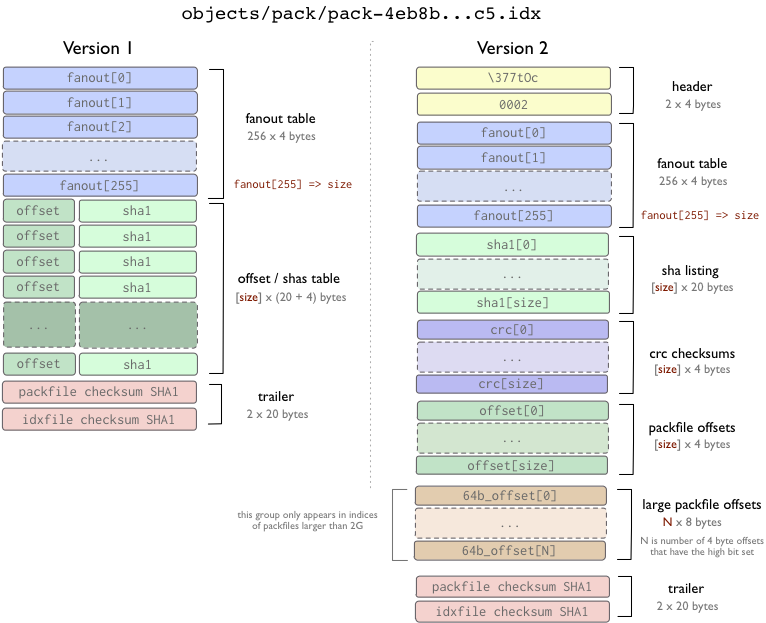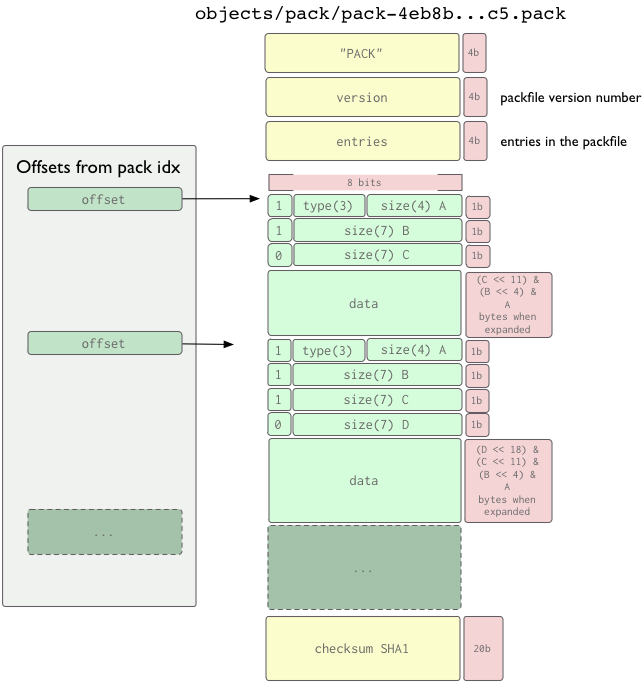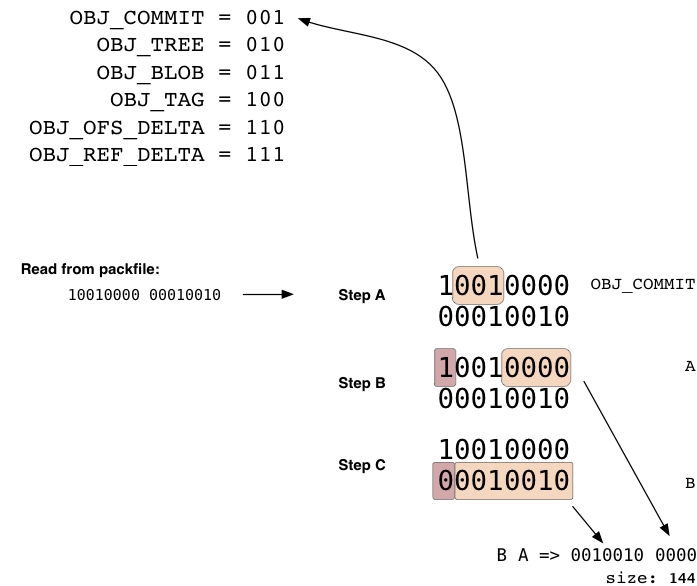The Packfile
This chapter explains in detail, down to the bits, how the packfile and pack index files are formatted.
The Packfile Index
First off, we have the packfile index, which is basically just a series of bookmarks into a packfile.
There are two versions of the packfile index - version one, which is the default in versions of Git earlier than 1.6, and version two, which is the default from 1.6 forward, but which can be read by Git versions going back to 1.5.2, and has been further backported to 1.4.4.5 if you are still on the 1.4 series.
Version 2 also includes a CRC checksum of each object so compressed data can be copied directly from pack to pack during repacking without undetected data corruption. Version 2 indexes can also handle packfiles larger than 4 Gb.

In both formats, the fanout table is simply a way to find the offset of a particular sha faster within the index file. The offset/sha1[] tables are sorted by sha1[] values (this is to allow binary search of this table), and fanout[] table points at the offset/sha1[] table in a specific way (so that part of the latter table that covers all hashes that start with a given byte can be found to avoid 8 iterations of the binary search).
In version 1, the offsets and shas are in the same space, where in version two, there are seperate tables for the shas, crc checksums and offsets. At the end of both files are checksum shas for both the index file and the packfile it references.
Importantly, packfile indexes are not neccesary to extract objects from a packfile, they are simply used to quickly retrieve individual objects from a pack. The packfile format is used in upload-pack and receieve-pack programs (push and fetch protocols) to transfer objects and there is no index used then - it can be built after the fact by scanning the packfile.
The Packfile Format
The packfile itself is a very simple format. There is a header, a series of packed objects (each with it's own header and body) and then a checksum trailer. The first four bytes is the string 'PACK', which is sort of used to make sure you're getting the start of the packfile correctly. This is followed by a 4-byte packfile version number and then a 4-byte number of entries in that file. In Ruby, you might read the header data like this:
def read_pack_header sig = @session.recv(4) ver = @session.recv(4).unpack("N")[0] entries = @session.recv(4).unpack("N")[0] [sig, ver, entries] end
After that, you get a series of packed objects, in order of thier SHAs which each consist of an object header and object contents. At the end of the packfile is a 20-byte SHA1 sum of all the shas (in sorted order) in that packfile.

The object header is a series of one or more 1 byte (8 bit) hunks that specify the type of object the following data is, and the size of the data when expanded. Each byte is really 7 bits of data, with the first bit being used to say if that hunk is the last one or not before the data starts. If the first bit is a 1, you will read another byte, otherwise the data starts next. The first 3 bits in the first byte specifies the type of data, according to the table below.
(Currently, of the 8 values that can be expressed with 3 bits (0-7), 0 (000) is 'undefined' and 5 (101) is not yet used.)
Here, we can see an example of a header of two bytes, where the first specifies that the following data is a commit, and the remainder of the first and the last 7 bits of the second specifies that the data will be 144 bytes when expanded.

It is important to note that the size specified in the header data is not the size of the data that actually follows, but the size of that data when expanded. This is why the offsets in the packfile index are so useful, otherwise you have to expand every object just to tell when the next header starts.
The data part is just zlib stream for non-delta object types; for the two
delta object representations, the data portion contains something that
identifies which base object this delta representation depends on, and the
delta to apply on the base object to resurrect this object. ref-delta
uses 20-byte hash of the base object at the beginning of data, while
ofs-delta stores an offset within the same packfile to identify the base
object. In either case, two important constraints a reimplementor must
adhere to are:
delta representation must be based on some other object within the same packfile;
the base object must be of the same underlying type (blob, tree, commit or tag);
